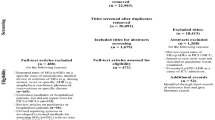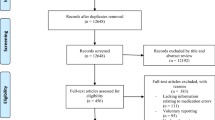Abstract
In paediatric medicine, drug doses are usually calculated individually based on the patient’s age, weight and clinical condition. Therefore, there are increased opportunities for, and a relatively high risk of, dosing errors in this setting. Consequently, a systematic literature review using several databases was conducted to investigate the incidence and nature of dosing errors in children; 16 studies were found to be relevant.
Eleven of the 16 studies found that dosing errors are the most common type of medication error, three of the remaining studies found it to be the second most common type. This review of published research on medication errors therefore suggests that dosing errors are probably the most common type of error in the paediatric population. In addition, there was a great variation in the error rates reported; this is likely to be due to the differences in the medication error definitions and methodologies employed. For example, the dosing error rate determined using spontaneous reporting ranges from 0.03 per 100 admissions in the UK to 2 per 100 admissions in the US. Extrapolating this, if the under-reporting rate is about 1 in 100, then the true incidence would be around 50 000 paediatric dosing errors per year in England.
The information available shows that dosing errors are not uncommon and that 10-fold overdoses caused by calculation errors have led to serious consequences. There is an urgent need to develop methods to reduce medication errors in children and dosing errors should be the first priority.



Similar content being viewed by others
References
Kohn LT, Corrigan JM, Donaldson MS. To err is human: building a safer health system. Washington, DC: Institute of Medicine National Academy Press, 1999
Department of Health. An organisation with a memory. London: The Stationery Office, 2000 [online]. Available from URL: http://www.doh.gov.uk/orgmemreport/orgmemexecsum.htm [Accessed 2003 Mar 10]
Department of Health. Building a safer NHS for patients. London: The Stationery Office, 2001 [online]. Available from URL: http://www.doh.gov.uk/buildsafenhs [Accessed 2003 Oct 12]
Kaushal R, Bates DW, Landrigan C, et al. Medication errors and adverse drug events in pediatric inpatients. JAMA 2001; 285(16): 2114–20
Barber ND, Batty R, Ridout DA. Predicting the rate of physician- accepted interventions by hospital pharmacists in the United Kingdom. Am J Health Syst Pharm 1997; 54: 397–405
Davies C. Junior doctor is cleared in baby overdose death, 1999 [online]. Available from URL: http://www.portal.telegraph.co.uk/htmlContent.jhtml?.html=/archive/1999/04/21/ndoc21.html [Accessed 2003 Oct 19]
Cousins D, Clarkson A, Conroy S, et al. Medication errors in children: an eight year review using press reports. Paediatr Perinat Drug Ther 2002; 5(2): 52–8
Child given the wrong treatment. Nurs Times 2001; 97 (8): 7
Selbst SM, Fein JA, Osterhoudt K, et al. Medication errors in a pediatric emergency department. Pediatr Emerg Care 1999; 15(1): 1–4
Koren G, Barzilay Z, Greenwald M. Tenfold errors in administration of drug doses: a neglected iatrogenic disease in pediatrics. Pediatrics 1986; 77: 848–9
Koren G, Haslam RH. Pediatric medication errors: predicting and preventing tenfold disasters. J Clin Pharmacol 1994; 34: 1043–5
O’Shea E. Factors contributing to medication errors: a literature review. J Clin Nurs 1999; 8: 496–504
Allan EL, Barker KN. Fundamentals of medication error research. Am J Hosp Pharm 1990; 47: 555–71
Kozer E, Scolnik D, Macpherson A, et al. Variables associated with medication errors in pediatric emergency medicine. Pediatrics 2002; 110(4): 737–42
Raju TNK, Kecskes S, Thornton JP, et al. Medication errors in neonatal and paediatric intensive care units. Lancet 1989; II: 374–6
Tisdale JE. Justifying a pediatric critical-care satellite pharmacy by medication error reporting. Am J Hosp Pharm 1986; 43: 368–71
Hall KW, Ebbeling P, Brown B, et al. A retrospective-prospective study of medication errors: basis for an ongoing monitoring program. Can J Hosp Pharm 1985; 38: 141–3
Barker KN, McConnell WE. The problems of detecting medication errors in hospitals. Am J Hosp Pharm 1962; 19: 360–9
McNally KM, Sunderland VB. No-blame medication administration error reporting by nursing staff at a teaching hospital in Australia. Int J Pharm Pract 1998; 6: 67–71
Jha AK, Kuperman GJ, Teich JM, et al. Identifying adverse drug events: development of a computer-based monitor and comparison with chart review and stimulated voluntary report. J Am Med Inform Assoc 1998; 5(3): 305–14
Kaushal R. Using chart review to screen for medication errors and adverse drug events. Am J Health Syst Pharm 2002; 59(23): 2323–5
Dean BS, Kanabar P, Ashby N, et al. What can the medication chart tell us about medication administration? Hosp Pharm 1998; 5: 167–70
Bruce J, Wong ICK. Parenteral drug administration errors by nursing staff on an acute medical admissions ward during day duty. Drug Saf 2001; 24(11): 855–62
Dean B, Barber N. Validity and reliability of observational methods for studying medication administration errors. Am J Health Syst Pharm 2001; 58: 54–9
Barber N, Dean B. The incidence of medication errors and ways to reduce them. Clinical Risk 1998; 4: 103–6
Taxis K, Dean B, Barber N. Hospital drug distribution systems in the UK and Germany: a study of medication errors. Pharm World Sci 1999; 21(1): 25–31
Bordun LA, Butt W. Drug errors in intensive care. J Paediatr Child Health 1992; 28: 309–11
Blum KV, Abel SR, Urbanski CJ, et al. Medication error prevention by pharmacists. Am J Health Syst Pharm 1988 Sep; 45(9): 1902–3
Folli HL, Poole RL, Benitz WE, et al. Medication error prevention by clinical pharmacists in two children’s hospitals. Pediatrics 1987; 79(5): 718–22
Cowley E, Williams R, Cousins D. Medication errors in children: a descriptive summary of medication error reports submitted to the United States Pharmacopeia. Curr Ther Res Clin Exp 2001; 62(9): 627–40
Ross LM, Wallace J, Paton JY. Medication errors in a paediatric teaching hospital in the UK: five years operational experience. Arch Dis Child 2000; 83: 492–7
Wilson DG, McArtney RG, Newcombe RG, et al. Medication errors in paediatric practice: insights from a continuous quality improvement approach. Eur J Pediatr 1998; 157: 769–74
Paton J, Wallace J. Medication errors. Lancet 1997; 349(9056):959–60
Aneja S, Bajaj G, Mehandiratta SK. Errors in medication in a pediatric ward. Indian J Pediatr 1992; 29: 727–30
Jonville APE, Autret E, Bavoux F, et al. Characteristics of medication errors in pediatrics. DICP 1991; 25: 1113–7
Schneider MP, Cotting J, Pannatier A. Evaluation of nurses’ errors associated in the preparation and administration of medication in a pediatric intensive care unit. Pharm World Sci 1998; 20(4): 178–82
Fontan JE, Maneglier V, Nguyen VX, et al. Medication errors in hospitals: computerized unit dose dispensing system versus ward stock distribution system. Pharm World Sci 2003; 25(3): 112–7
Smetzer JL, Cohen MR. Lesson from the Denver medication error/criminal negligence case: look beyond blaming individuals. Hosp Pharm 1998; 33: 640–57
Diav-Citrin O, Ratnapalan S, Grouhi M, et al. Medication errors in paediatrics: a case report and systemic review of risk factors. Paediatr Drugs 2000; 2(3): 239–42
Department of Health, Hospital Episode Statistics - 2001/02. Ungrossed data [online]. Available from URL: http://www.doh.gov.uk/hes/tables/tbcv101e.xls [Accessed 2003 Oct 16]
Lesar TS. Tenfold medication dose prescribing errors. Ann Pharmacother 2002; 36: 1833–9
Lesar TS. Errors in the use of medication dosage equations. Arch Pediatr Adolesc Med 1998; 152: 340–4
Wong ICK, Dimah S, Cope J, et al. Paediatric medicines research in the UK: how to move forward? Drug Saf 2003; 26(8): 529–37
Rowe C, Koren T, Koren G. Errors by paediatric residents in calculating drug doses. Arch Dis Child 1998; 79(1): 56–8
Glover ML, Sussmane JB. Assessing pediatrics residents’ mathematical skills for prescribing medication: a need for improved training. Acad Med 2002; 77(10): 1007–10
Gladstone J. Drug administration errors: a study into the factors underlying the occurrence and reporting of drug errors in a district general hospital. J Adv Nurs 1995, 37
Acknowledgements
Dr Ian Wong is funded by the UK Department of Health, National Public Health Career Scientist Award. Miss Maisoon Abdullah Ghaleb is partly funded by the UK Overseas Research Scholarship. Professor Nick Barber, Drs Bryony Dean Franklin and Ian Wong have received funding from the UK Medical Research Council and UK Department of Health in the research of medication errors and the use of technology in their reduction.
The authors have no conflicts of interest that are directly relevant to the content of this review.
Author information
Authors and Affiliations
Corresponding author
Rights and permissions
About this article
Cite this article
Wong, I.C., Ghaleb, M.A., Franklin, B.D. et al. Incidence and Nature of Dosing Errors in Paediatric Medications. Drug-Safety 27, 661–670 (2004). https://doi.org/10.2165/00002018-200427090-00004
Published:
Issue Date:
DOI: https://doi.org/10.2165/00002018-200427090-00004




